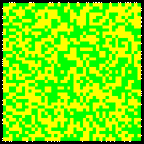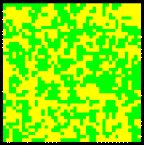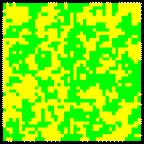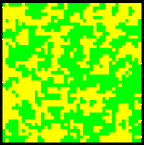Ethics Decision Theory Simulations
by Joseph Schreiner
Defining Groups and Their Encounter Scenarios
To explore the effects of group membership, I ran simulations with C++ programs on my Linux RedHat machine, and analyzed the results with commercial statistical software on my Windows 98 machine. To make the analysis tractable, I was forced to prune the number of scenarios.

First, I performed no analyses with multiple groups. Multiple-group scenarios are unnecessary. The outcome of any multiple-group scenario is simply the linear sum of the proportion of within-group encounters vs. the proportion of outside-group encounters. We already know the results of outside-group encounters, as they are described elsewhere on this web site. The information we need can only be derived from an analysis of within-group encounters. So all scenarios contained just one group, with all Agents members of that group.
Second, I only ran the more rational Self-Gain strategies, as determined by previous analyses. I did not waste resources on clearly dysfunctional strategies (Assume Death-Wish, Least Surprise, Most Surprise, and Random). Only 36 overall strategies were considered. These were all possible combinations of:

6 Basic Strategies by
3 levels of Good/Bad-Will by
2 levels of Reciprocity
The 6 Basic Strategies were Best Cell, Best Row, Minimize Loss, Assume Selfish, Assume Persecution, and Assume Benevolence.
The 3 levels of Good/Bad-Will were Good Will, Neutral Will, and Bad Will.
The 2 levels of Reciprocity were Responsive and Not Responsive.
Third, I only ran Challenging scenarios (the correlation between Self and Other Payoffs was –0.50). The Challenging scenarios are the most interesting, ethically, in that each encounter is competitive, but it is still possible for both Agents to gain.

The overall ethical strategies have been defined in great detail on other pages. Now mutual support requires quantitative definitions. At the risk of political overtones, I define mutual support levels as Tax Rate. This is the percentage of an Agent’s gain (or loss) that is transferred to the entire group. This transfer is to an impersonal Group Treasury. At the end of an encounter scenario, the Group Treasury is returned to all group members, with each member receiving an equal share.
I ran my analyses with five possible Tax Rates – 0%, 25%, 50%, 75%, and 100%. For example, if an Agent had a 50% Tax Rate, after each encounter, 50% of the gain/loss was transferred to the Group Treasury. The Agent retained the remaining 50%. At a 100% Tax Rate, all encounter gain/loss was transferred to the Group Treasury; the Agent retained none. At a 0% Tax Rate, no gain/loss was transferred to the Group Treasury; the Agent retained all.

Even here, I had to simplify my model of mutual support. I allow contribution to group welfare to vary (Tax Rate), but keep group support constant (all group members receive an equal share of the Group Treasury). I could have defined a model where group members receive unequal amounts of support, but chose not to do so. I had to keep the number of scenarios manageable. I could also have defined a model where all group members make equal contributions to the Group Treasury (Equal Tax Rates), but where the Group Treasury is unequally distributed among members.
Given these two dimensions of group membership - a common ethical strategy and/or mutual support - I ran all four possible combinations of group membership. In each scenario, all Agents are members of a single group.
1) Many Strategies/Many Tax Rates – Agents shared no common ethical strategy (all 36 strategies were equally represented within the group). There was a Group Treasury, but group members made unequal contributions to it (all 5 Tax Rates were equally represented). This scenario consisted of one simulation of 1800 Agents. There were 10 Agents for each of the 180 combinations of 36 ethical strategies by 5 Tax Rates. This is the least cohesive of groups.
2) Same Strategy/Many Tax Rates – All Agents used the same ethical strategy. However, Agents made a different contribution to the Group Treasury. This scenario consisted of 36 simulations (one for each overall ethical strategy) of 50 agents. Each simulation had 10 Agents for each of the 5 Tax Rates (0%, 25%, 50%, 75%, 100%).
3) Many Strategies/Same Tax Rate - All Agents made equal contributions to the Group Treasury, but Agents used different ethical strategies. This scenario consisted of 5 simulations (one for each Tax Rate) with 360 Agents (10 Agents for each of the 36 overall ethical strategies).
4) Same Strategy/Same Tax Rate – All Agents used the same ethical strategy. All Agents made equal contributions to the Group Treasury. This scenario consisted of 180 simulations, one for each unique combination of 36 ethical strategies and 5 Tax Rates. Each simulation had 50 Agents. This was the most cohesive of group types.